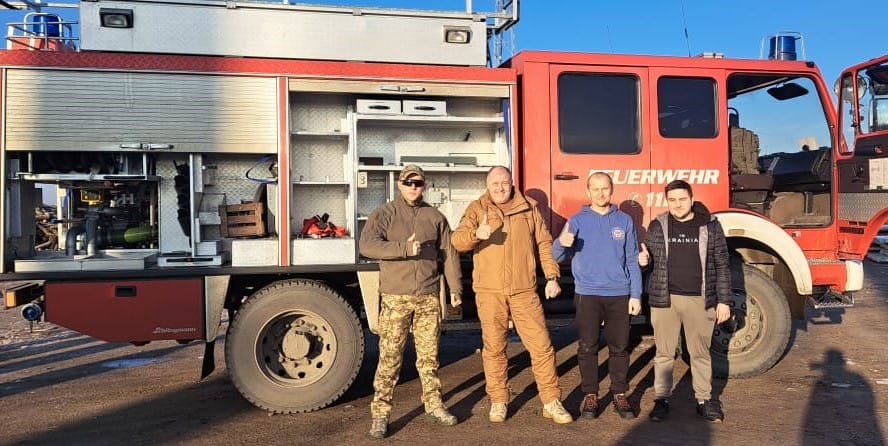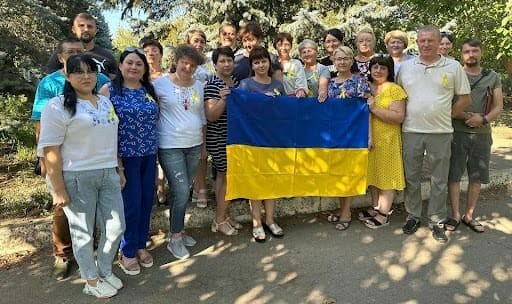This website uses cookies so that we can provide you with the best user experience possible. Cookie information is stored in your browser and performs functions such as recognising you when you return to our website and helping our team to understand which sections of the website you find most interesting and useful.
Dariivka Territorial Community

The village of Dariivka is the centre of the Dariivka Village Council located on the right bank of the Inhulets River, 14 kilometres away from the regional centre of the city of Kherson, 80 kilometres away from the city of Mykolaiv. Roads of state importance pass through the territory of the Community.
The total territory of the Community ranks third in terms of its size in the Kherson (Bilozerske) District and occupies 44.2 thousand hectares. The Community includes five Starosta-headed districts, which consist of fifteen localities.
On 17 July 2020, as a result of the administrative-territorial reform and liquidation of the Bilozerske District, the Community became part of the Kherson District.
The population of the Community amounted to 14,414 residents as of 2022 and 6,952 residents as of 30 November 2023.
Men: 3,296 residents
Women: 3,656 residents
0-17 years old: 918 residents
18-59 years old: 2,544 residents
60 years and older: 3059 residents
There are about 1,000 internally displaced persons in the Community.
History
The Inhulets River is the right tributary of the Dnipro. This is the second most important river of the Kherson Region. The length of its channel is 549 kilometres. It is one of the most winding rivers in Europe. The territory between the Inhul River and the Inhulets River was called Uhol, and the tribes of Slavs who lived there were called Uhlychi. When the Turkic tribes displaced the Slavs, these places began to be called Inhul, and the large river that flowed there was named Inhul. And the neighbouring river was called Maly (Small) Inhul for a long time. Later it was named Inhulets.
Since ancient times, the banks of the Inhulets River have attracted the attention of nomads. There are archaeological sites there dating back to the Cimmerian, Scythian and medieval times. Ancient barrows rise in the steppes adjacent to the Inhulets River. The Inhulets River banks were also actively inhabited by Zaporizhia Cossacks.
In 1774, there were eleven Cossack winter settlements near the Inhulets River, many of which gave names to present-day villages.

An early Scythian settlement was situated on the left bank of the Inhulets River. Three kilometres to the north, on the right bank of the Inhulets River, there is a late Scythian settlement of the 2nd – 4th centuries AD, where stone buildings and ceramics of the Cherniakhiv culture were discovered. A Scythian burial mound dating back to the 6th century BC was explored on the Baida site.
The Fedorivska Cave is a geological landmark of local importance. Its surface area amounts to 0.5 hectares. The Fedorivska Cave is a unique natural formation, which is a botanical natural landmark having a special environmental, scientific, aesthetic and cognitive significance. The Cave is located in the lower reaches of the Inhulets River. There you can see various species of rare and endangered plants.

The village of Dariivka was founded on 08 June 1780 by Count Fedir Komstadius, a descendant of a famous Swedish family. Fedir Saveliiovych founded three factories in Faleivka (now the village of Sadove): a vinegar factory, a silk factory, and a distillery. A family necropolis was also established there.
Later, Fedir Komstadius acquired the neighbouring lands around Faleivka from Faleev’s niece Avdotia. He founded the Dariivka estate, named after his wife Dorothea (Daria) and Antonivka in honour of his son Anton.
Earlier, the village belonged to the Mykil Volost of the Kherson District in the Kherson Province. As of 1886, 169 people lived in the village, there were 29 yards, a post office, a community station, a church-parish school opened in 1862, an inn, a bridge over the Inhulets River.
The village suffered from the Great Famine organized in 1932-1933.

Economy and Welfare
The economic base of the Community is formed by enterprises and individual entrepreneurs. In total, more than 200 enterprises of various forms of ownership operate in the territory of the Community. During the period of martial law, many enterprises have ceased their operations.
The key lines of business of those enterprises includes: cultivation of agricultural products, horticultural societies engaged in the cultivation of fruit and vegetable crops, production of sunflower oil.
Ukraine’s largest garden society “Platan” works in the territory of the Community.
Fifty-five private entrepreneurs are engaged in trade in the territory of the Community. Five communal enterprises operate in the territory of the Community providing the population with water supply and other communal services.
Before the full-scale invasion, seven lyceums and two secondary schools, seven preschools, nine paramedic and midwife centres, two outpatient clinics, nine culture centres and clubs, and two prisons functioned in the territory of the Community.
The residents of the Community are very united. Celebrations of the Village Day, national and state holidays are traditional there. The nongovernmental organization “Dariivka Community. Together Strong!” actively works in the village of Dariivka.

The nongovernmental organization organizes various cultural and sports festivals, clean-up




Community and War
In February 2022, already in the first days of the full-scale invasion, the Community found itself under occupation, which lasted for nine months. During the long period of occupation by russian troops, the Community lived completely without electricity, without water and practically without food. Thus, the villages were practically on the verge of a humanitarian disaster. And all this was accompanied by constant terror against the local population and searches conducted by the russians. In addition, the invaders did everything to limit the residents’ access to mobile communications and the Internet.
On the morning of 23 July 2022, in order to create problems for the supply of the russian group of invaders on the right bank of the Dnipro in the Kherson Region, the Ukrainian military hit the Dariivka Bridge across the Inhulets River.

Thus, the bridge in the direction of the Kakhovka HPP was damaged.

On the morning of 09 November 2023, during the escape of russian troops to the left bank of the Kherson Region, the Dariivka bridge was finally blown up.

Due to the lack of a bridge in the Community, the logistical situation is complicated as the Community is separated into two banks by the Inhulets River.
Today, all the villages are located in the territory controlled by Ukraine. The bridge on the Inhulets River is destroyed, its restoration is not planned in the near future due to daily shelling, and the detour is up to 80 kilometres long.
On 11 November 2023, the Community was liberated by the Armed Forces of Ukraine. After the liberation, the Community has been under constant fire from the russian army.

After the de-occupation, the Community has suffered a great disaster due to flooding following the explosion of the Kakhovka HPP with 252 buildings being damaged.

After the russians blew up the Kakhovka HPP dam, the water level rose in the Inhulka River, whose waves flooded the villages situated near the banks. Several streets were completely flooded in the villages of Dariivka, Fedorivka, Yasna Poliana, Inhulets, and Telmana.



On the night of November 5, the russian military fired a guided aerial bomb at the lyceum in the village of Dariivka.
As of January 2024, the following buildings were damaged or destroyed in the Dariivka Community:
- Inhulets, Dariivka lyceum – destroyed;
- ten educational institutions – damaged;
- six medical institutions – damaged;
- seven culture centres;
- 1,055 houses.


Since the beginning of the war, eighteen local residents have been killed, including two children in the village of Poniativka, and twenty-three residents of the Community have been injured.
People of the Community
Since 15 June 2023, the Dariivka Community has been headed by Anatolii Didur.
Since his appointment, Anatolii Didur has been able to quickly and effectively respond to all emergency situations that emerge in the Community localities.
Work of humanitarian centres in close cooperation with international organizations and the Regional Military Administration has been organized; building materials, food products are delivered; restoration work and landscaping works are carried out, stationary shelters have been installed, cost estimates have been developed for the repair of basement shelters, they are being repaired, the Community receives equipment, the Administrative Services Centre has been opened.

The Dariivka Community received a fire truck from Germany from the German city of Sindelfingen and the Cities 4 Cities project | United 4 Ukraine project.

Thanks to the cooperation with the DOBRE Program, an aerial work platform was delivered to the Dariivka Community as part of the ERP-3 project.

Efforts are made to help the elderly, people with disabilities, and other needy people by engaging twenty-five people in community service with funding from the regional employment centre, employing twenty social workers with funding from the local budget and with the support of the Red Cross.
The project “Network of Social Laundries” is implemented in the territory of the Community, and funding from international organizations has already been obtained; three industrial washing machines and three dryers have been installed to provide services to the relevant categories of residents.
Ihor Lapin, the starosta of the Inhulets Starosta-Headed District. As soon as the invaders set foot on the land of the Kherson Region, Ihor Lapin decided to defend the Motherland and joined the ranks of the Territorial Defence Unit. He is a participant in the battles near the Kherson boarding school. And the Ukrainian military, including Ihor Lapin, stopped the movement of the invaders.
Ihor Lapin received three wounds in that battle. Now Ihor Lapin continues to work. This is the elimination of the consequences of flooding, and the provision of firewood, food and medicines, the elimination of the consequences of constant shelling. As a result of his devotion to the people and determination in the battle, he was awarded the Order of Merit, III degree.

Development Strategy
The key goals and objectives to be achieved by the Community include:
- building bomb shelters in the Community;
- improving the system of social services;
- restoring the housing sector and ensuring housing renovation;
- rebuilding the destroyed infrastructure facilities;
- preparing for the heating season, modernizing the heating system and installing alternative heating sources;
- developing a high-quality waste management system;
- restoring and repairing roads and sidewalks;
- organizing transport connections;
- developing a high-quality water supply and drainage system;
- increasing the level of medical services.

List of Sources
- facebook.com
- slovoidilo.ua
- investigator.org.ua
- M. Didura’s personal album
- Danylo Shchohol’s personal album
- Natalia Hrydina’s personal album
